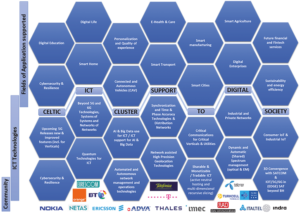Ambitious roadmap for 2021 – 2025

Xavier Priem
Director CELTIC Office
CELTIC-NEXT has been relaunched with a new, ambitious roadmap as part of the revised Eureka Clusters Programme. The relaunch is very timely in a world of dramatic change that requires novel ICT solutions addressing the economic, societal, and environmental challenges the Eureka member states and the world as a whole are facing.
The revised Eureka Clusters Programme
The CELTIC-NEXT Cluster application for the four-year period 2021-2025 was accepted, together with the Multi-Annual Plan for the Eureka Clusters, on 18th June 2021. This concluded a relaunch process that had started in June 2020. The new Eureka Clusters model is meant to encourage industry-wide collaboration and the forming of new innovation ecosystems. The revised Eureka Clusters Programme aims to align and synchronise the Clusters’ processes.
Since June 2020, the Eureka Clusters had already intensified their joint and synchronised activities, most visibly through two jointly organised AI calls in 2020 and 2021, which both mobilised a substantial number of excellent project proposals.

Topical areas of the CELTIC-NEXT Roadmap 2021–2025
Updated CELTIC-NEXT roadmap for 2021 – 2025
The theme of CELTIC-NEXT for the new period is: “Next-Generation Communications for a secured, trusted, and sustainable digital society”. All topics identified in the strategic roadmap of CELTIC-NEXT for the 2021–2025 period have been aligned under this theme. These topics are neither comprehensive nor prescriptive. In line with the bottom-up approach of CELTIC-NEXT, projects are free to explore any subject, as long as it is related to ICT and telecommunications.
A core part of the roadmap relates to the evolution of communication networks. The roadmap identifies the ongoing digitisation and automation of many aspects of our lives as fundamental drivers for transforming the communications network architecture and functionality. The shift to automation of everything is driven by current enabling technology trends like cloud-based services with dynamic, adaptive scaling, extensive virtualisation, novel software-defined automated solutions and ever-increasing wireless connectivity with a great promise of 5G, Beyond 5G, and the nascent 6G, and will require a redefinition of networking concepts and a new digital infrastructure involving radical shifts in technologies, architectures and business models to meet future digital needs.
The roadmap highlights a number of important trends and requirements expected to shape the projects and results of the CELTIC-NEXT Cluster in the coming years, including: pervasiveness, almost infinite network capacity, imperceptible latency, tera-scale things, cognitive operations, and perpetual protection.
Addressing the digital needs will require significant changes in network architecture and technology. Nine dimensions are identified in the roadmap towards an end-to-end convergent network architecture: 1. Massive-scale access, 2. Converged edge cloud, 3. Smart network fabric, 4. Universal adaptive core, 5. Programmable network operating system, 6. Network slicing, 7. Augmented cognition systems, 8. Digital value platforms, and 9. Dynamic data security.
Further related areas of the roadmap beyond communication networks in the narrow sense include: cybersecurity, artificial intelligence and big data, ICT solutions for sustainability, ICT-enabled health and wellness, new solutions for consumption and production, smart cities and smart territories, smart transport, smart energy, smart agriculture, smart home and smart building, digital enterprise and digital education, content, entertainment and gaming, fintech, and digital life services.
Many of the topics identified in the roadmap go across several Eureka Clusters, which is intentional, as ICT is at the core of innovation in all vertical sectors. In line with the concept of the revised Cluster Programme, CELTIC-NEXT will use these cross-Cluster topics as opportunities for creating synergies and increasing impact across the whole programme. Only in this way can CELTIC-NEXT and the other Clusters in the programme continue delivering top-level industry-driven innovations addressing the needs of economy, society and environment. In line with this cross-Cluster collaboration spirit, CELTIC-NEXT is one of three Core Technologies Clusters, together with partner Clusters ITEA (software) and Xecs (hardware). As a Pillar Cluster, CELTIC-NEXT supports the two more application-based Clusters EUROGIA2020 (low-carbon energy technologies) and SMART (manufacturing).
Excellence targets
CELTIC-NEXT has defined a set of excellence targets in order to keep its activities focused on achieving substantial measurable impacts. These targets are divided into three areas:
1. Technical excellence targets
› Accelerate the deployment and take-up of new advanced end-to-end ICT services, employing the new network concepts of 5G and leading to the implementation of 6G in Europe
› Actively facilitate the adoption of those ICT technologies by all targeted Verticals into their communities, business models and processes
2. Economic excellence targets
› Consolidate the position of European ICT manufacturers and service providers within Europe and on the global market
› Contribute to all Eureka Communities tackling the technological and socio-economic challenges in a holistic way by considering the end-to-end perspective of new communications solutions
3. Societal and environmental excellence targets
› Investigate where advanced communications can reduce carbon footprints for many vertical sectors
› Assist European nations and industry to access the societal benefits and returns of being at the forefront of the new digital society
› Consolidate the European sovereignty in ICT technologies and services as well as other critical infrastructures relying on ICT infrastructures, like the Energy Grid
These targets are highly ambitious and require close collaboration between the private and the public sector. The revised Eureka Clusters Programme provides the structure and the ecosystem to achieve them.